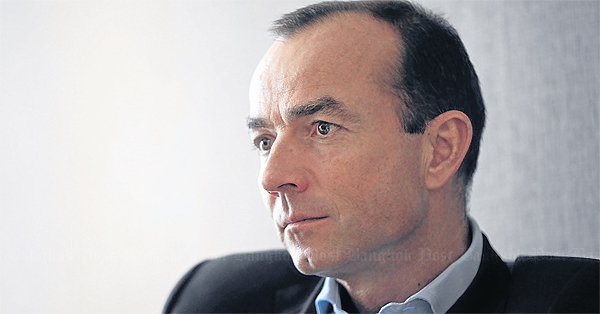Hilton Worldwide has set an ambitious target to open one new hotel a week in Asia in 2015 and make the region the group’s key player within the next few years.

The surge in Chinese travel is pushing hotel expansion throughout Asia, says Mr Rinck.
The company just celebrated the opening of its 100th property, the first DoubleTree by Hilton Sukhumvit in central Bangkok. It now has 170 properties under development, 90% of them managed by Hilton, said Martin Rinck, president for Asia Pacific of Hilton Worldwide.
Four years ago, Hilton Worldwide had just 46 hotels in Asia Pacific. Last year, it signed 55 new deals to manage hotels in this region.
“We aim to open 25 hotels this year and 35 in 2014. And we target to open one hotel a week in 2015. That means we will have 52 hotels under our brands in a year,” he said.
Hilton Worldwide now has 10 brands under its umbrella: Waldorf Astoria and Conrad in the luxury segment; Hilton Grand Vacations for the timeshare or “vacation ownership” market; Hilton, DoubleTree by Hilton and Embassy Suites in the full-service segment; and Hilton Garden Inn, Hampton, Homewood Suites by Hilton and Home 2 Suites by Hilton in the “focused service” or budget segment for travelers. It currently markets only six of the brands in Asia Pacific.
The biggest contribution Asia Pacific makes to the company is not in terms of hotel numbers or earnings but equity and brand awareness, which will translate into greater earnings in the future. For example, half of the company’s 22 Conrad hotels are in Asia Pacific, as are 16 of the 18 now under construction globally.
Mainland China is the most important market for Hilton in terms of numbers. Thirty-four of its 100 hotels are in China, along with 120 of the 170 under development. The demographic trend is driving demand in a country where an estimated 160 cities have populations higher than one million. As well, tourism is booming, with 85% of those travelers being domestic.
Apart from mainland China, Hilton is also bullish on India, Indonesia, Malaysia and Thailand. In India, the company has grown from zero in late 2009 to 12 properties, with 25 more in the pipeline. These countries as well as other developing ones in Asia Pacific are in the high-growth group for Hilton. Markets such as Japan and Australia, while still very important, will not see growth at the same pace.
“The fundamentals in Asia Pacific are very positive,” said Mr Rinck.
According to a recent report by the property services firm CBRE, Asia Pacific was the world’s fastest growing tourism market in 2012 with more than 5% growth or 18 million tourists. Total foreign tourists in this region were 350 million, a record year. The Japan and Thailand tourism markets recovered last year, while other Southeast Asian countries are growing very rapidly: Myanmar at 52%, Cambodia 24% and Laos 22%. Southeast Asia overall led the world with a 9.9% increase in visitors.
Chinese visitors last year made 83.18 million outbound trips, an increase of 18.4%. The number this year is expected to increase by 12-15%. The continuous growth will benefit hotels in Southeast Asia.
The hotel market remained positive in 2012 but grew at a slower rate compared with 2011. Revenue per available room (RevPAR) in China, India and Vietnam softened due to the decline in occupancies and average daily room rates (ADRs).
Last year 82,476 rooms were added to the Asia Pacific hotel market. The upscale segment took the largest share of 20.7% or around 17,000 rooms.
CBRE estimated that 380,000 rooms or 1,780 hotels would be added to the Asia Pacific hotel market over the next two years. Twenty percent of those rooms would be in upscale and luxury properties focused on Shanghai, Bali, Jakarta, Beijing and Singapore. The investment value in 2013 is expected to grow from $5.5 billion in the previous year.
Mr Rinck said some people might think that a hotel management company would be content with one property under its brand in a given location, but Hilton believes there is always room for more.
“We are always asked whether we can have more hotels developed under our brands in one location. In a developed city like New York, we have 35 properties, and a hotel management provider has roughly 350 hotels under different brands around Paris,” he said. “In Asia, Shanghai, for example, we have four properties in the city. We know that there is not only one downtown in a city. So, instead of thinking of having one hotel in a city, we are hoping to have more properties in one destination.”
The major challenge for the hotel industry in Asia Pacific, he said, was human capital. With the hospitality business growing so quickly, finding, training and retaining good people is getting harder. With 170 hotels in the pipeline, Hilton Worldwide needs to find 170 general managers and thousands more staff.
The problem is most acute in China where not only international brands, but also local investors are investing in new hotels.
“Everybody can build nice hotels, but not everybody can run nice hotels. That’s why we are committed to investing in building human resources,” he said.
“No matter whether we are in a good or a tough economic environment, we never cut the budget for this area. At the end of the day, we would like to create the DNA of Hilton people and career advancement for them.”